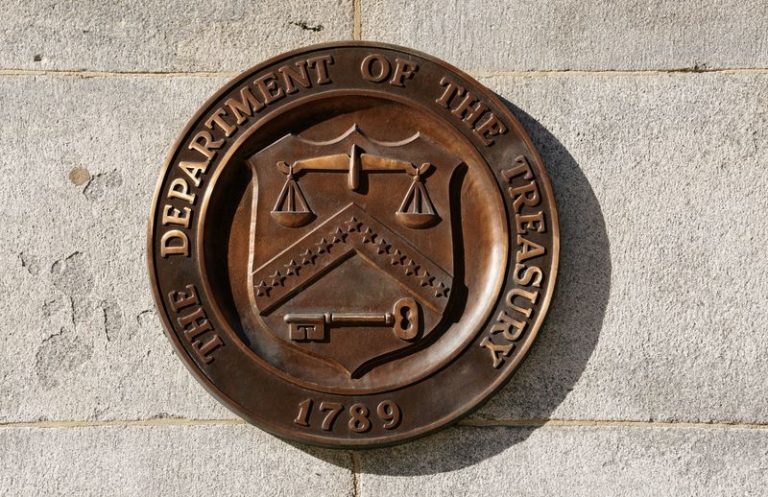By Mike Dolan
LONDON (Reuters) – Post-election U.S. reflation trades have quietly subsided and the world’s sovereign bond markets have confounded many doomsters to roar back to life, dragging government borrowing rates back down over the past fortnight.
It’s not at all obvious as to why. But it may simply reflect trade war anxiety and related world growth concerns, or fears of another geopolitical shock with a new government due in Washington, or maybe even thoughts of sliding oil prices if U.S. drilling goes up a gear. Or maybe it’s all three.
What this is not is a market overly anxious about a go-go world economy, re-aggravated inflation or excessive government debt.
In some respects, it’s the flipside of the market consensus on what another four years of Donald Trump in the White House might do to prices, one which riffs on yield curves steepening on new stimulus, a tariff-induced inflation resurgence and stalled central bank easing.
But however you characterize it, the reversal of the immediate post-election jolt in bond markets has been substantial across the developed world.
Europe and China stand out.
Since Nov. 7, the 10-year German bund yield has plummeted almost 50 bps, within a whisker of breaking 2% for the first time since the start of January.
While that may seem peculiar for a country facing elections in two months time, it’s likely a reflection of the additional pall Trump’s trade tariffs would throw over an already hobbled German and euro zone economy and stepped-up European Central Bank easing.
Jitters about the broader impact on the euro zone may give bunds something of a regional safety bid.
But even French 10-year yields have plunged as much as 40 bps since Nov. 7, as Paris has been mired in a government crisis that risks creating political and budgetary paralysis for several months.
China, facing investment curbs and eye-watering tariff threats from both outgoing and incoming U.S. administrations, saw its 10-year sovereign borrowing rates plumb sub-2% levels for the first time on record this week, a drop of almost 15 bps over the same time period.
And despite persistent evidence of exceptional U.S. growth, sticky inflation and widening budget deficits, long-dated U.S. Treasury yields too have dropped about 30 bps since the day after the election.
The widest possible index of global sovereign and corporate debt worldwide, the Bloomberg Multiverse index, saw implied yields drop 15 bps over that period as the index has jumped 1.5%.
INCOME IN UNCERTAINTY
What gives? One prosaic explanation is overly extreme positioning against sovereign debt in the run-up to the U.S. election is just being squared off into year end and the final central bank rate cuts of 2024 are due this month.
“Safe” sovereign debt allocations are often in large multi-country buckets anyway, which is why they are often priced in lockstep.
But it’s not at all that clear. The latest CFTC data shows speculative short positions on Treasury futures continued to rise in the latest week, even if these often say less about directional bets and mostly mirror asset manager demand.
The latest Bank of America global funds survey shows an outstanding underweight position in bonds worldwide last month, but it was substantially less than the previous month, even though respondents identified “short 30-year Treasury bond” as a fourth most crowded trade out there.
And underweight bond allocations more broadly are not especially extreme anyway – actually some 1.3 standard deviations above long-term averages.
So it may simply be that markets are just starting to price the global growth impact of a trade war, which Trump already appears determined to get underway in a series of tariff warnings to Mexico, Canada, China and the wider BRICS grouping of developing economies over the past week or so.
If countries offset those tariff rises by allowing their currencies to weaken, the U.S. dollar’s value could well be supercharged worldwide, and that would act as a drain on global financial conditions and liquidity by itself.
Even if U.S. growth were to continue to outperform in that world, it’s unlikely it could remain entirely undamaged by a large global demand hit.
But there’s another factor that may see 2025 end up being much kinder to bonds in general than many assumed, a return of so-called income investing.
In its secular long-term investment outlook this week, Swiss house Julius Baer (SIX:BAER) said income investing may well be back in vogue over the coming years so that bonds were no longer “priced for confiscation.”
And there was “insufficient evidence” to support a thesis of structurally higher-for-longer interest rates, it added, given that private sectors remained net savers in many countries.
“A steady income stream is even more valuable in times of macroeconomic uncertainty,” Julius Baer said.
And if global macroeconomic uncertainty really is good for world bonds, the rally of recent weeks should be no surprise.
The opinions expressed here are those of the author, a columnist for Reuters.
(by Mike Dolan X: @reutersMikeD)

